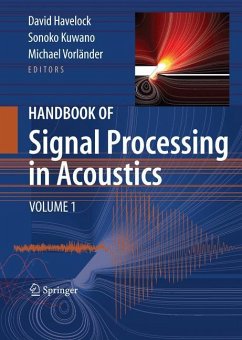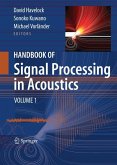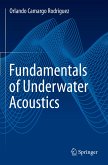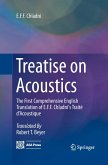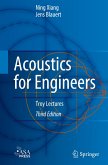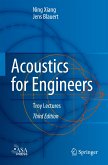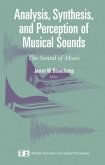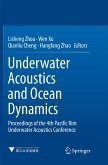Handbook of Signal Processing in Acoustics
Herausgeber: Havelock, David; Kuwano, Sonoko; Vorländer, Michael
Handbook of Signal Processing in Acoustics
Herausgeber: Havelock, David; Kuwano, Sonoko; Vorländer, Michael
- Broschiertes Buch
- Merkliste
- Auf die Merkliste
- Bewerten Bewerten
- Teilen
- Produkt teilen
- Produkterinnerung
- Produkterinnerung
Acoustics has a special relationship with signal processing. Many concepts in signal processing arise naturally from our general experience with sound and vibration and, more than in many other fields, acoustics is concerned with the acquisition, analysis, and synthesis of signals. Consequently, there is a rich resource of signal processing expertise within the acoustics community. There are many excellent reference books devoted to signal processing but the objective of the Handbook of Signal Processing in Acoustics is to bring together the signal processing expertise specific to acoustics…mehr
Andere Kunden interessierten sich auch für
![Handbook of Signal Processing in Acoustics Handbook of Signal Processing in Acoustics]() David Havelock / Sonoko Kuwano / Michael Vorländer (Hrsg.)Handbook of Signal Processing in Acoustics574,99 €
David Havelock / Sonoko Kuwano / Michael Vorländer (Hrsg.)Handbook of Signal Processing in Acoustics574,99 €![Fundamentals of Underwater Acoustics Fundamentals of Underwater Acoustics]() Orlando Camargo RodríguezFundamentals of Underwater Acoustics49,99 €
Orlando Camargo RodríguezFundamentals of Underwater Acoustics49,99 €![Treatise on Acoustics Treatise on Acoustics]() E. F. F. ChladniTreatise on Acoustics119,99 €
E. F. F. ChladniTreatise on Acoustics119,99 €![Acoustics for Engineers Acoustics for Engineers]() Ning XiangAcoustics for Engineers67,99 €
Ning XiangAcoustics for Engineers67,99 €![Acoustics for Engineers Acoustics for Engineers]() Ning XiangAcoustics for Engineers49,99 €
Ning XiangAcoustics for Engineers49,99 €![Analysis, Synthesis, and Perception of Musical Sounds Analysis, Synthesis, and Perception of Musical Sounds]() Analysis, Synthesis, and Perception of Musical Sounds75,99 €
Analysis, Synthesis, and Perception of Musical Sounds75,99 €![Underwater Acoustics and Ocean Dynamics Underwater Acoustics and Ocean Dynamics]() Underwater Acoustics and Ocean Dynamics112,99 €
Underwater Acoustics and Ocean Dynamics112,99 €-
-
-
Acoustics has a special relationship with signal processing. Many concepts in signal processing arise naturally from our general experience with sound and vibration and, more than in many other fields, acoustics is concerned with the acquisition, analysis, and synthesis of signals. Consequently, there is a rich resource of signal processing expertise within the acoustics community. There are many excellent reference books devoted to signal processing but the objective of the Handbook of Signal Processing in Acoustics is to bring together the signal processing expertise specific to acoustics and to capture the interdisciplinary nature of signal processing within acoustics. It is also hoped that the handbook will promote networking and the interchange of ideas between technical areas in acoustics. The handbook comprises 104 Chapters organized into 17 Parts. Each Part addresses a technical area of acoustics, reflecting the general demarcations of specialization within the acoustics community. An expert with broad knowledge of signal processing within their respective technical area was invited to act as a Section Leader for each Part of the handbook. These Section Leaders contributed substantially to the handbook project by helping to define the contents and scope of each chapter, finding an appropriate contributing expert author, and managing the review and revision of material. Collectively with the Editors, they form the Editorial Board for the handbook.
Produktdetails
- Produktdetails
- Verlag: Springer New York / Springer US / Springer US, New York, N.Y.
- Softcover reprint of the original 1st edition 2008
- Seitenzahl: 2004
- Erscheinungstermin: 23. August 2016
- Englisch
- Abmessung: 235mm x 178mm x 107mm
- Gewicht: 3406g
- ISBN-13: 9781493938391
- ISBN-10: 1493938398
- Artikelnr.: 48941627
- Herstellerkennzeichnung
- Springer-Verlag GmbH
- Tiergartenstr. 17
- 69121 Heidelberg
- ProductSafety@springernature.com
- Verlag: Springer New York / Springer US / Springer US, New York, N.Y.
- Softcover reprint of the original 1st edition 2008
- Seitenzahl: 2004
- Erscheinungstermin: 23. August 2016
- Englisch
- Abmessung: 235mm x 178mm x 107mm
- Gewicht: 3406g
- ISBN-13: 9781493938391
- ISBN-10: 1493938398
- Artikelnr.: 48941627
- Herstellerkennzeichnung
- Springer-Verlag GmbH
- Tiergartenstr. 17
- 69121 Heidelberg
- ProductSafety@springernature.com
David Havelock studied Mathematics and Physics as an undergraduate at Carleton University and obtained his M.Sc in Mathematics at the University of Bristish Columbia. After a period of employment in the areas of seismology and then submarine detection, he joined the Division of Physics at the National Research Council and completed his Ph.D. in Systems Engineering at Carleton University. While there, he has worked in Photogrammetric, Computer Imaging, and (since 1989) Acoustics. While in the Acoustics and Signal Processing Group of the Institute for Microstructural Sciences at the NRC, his main areas of research have been microphone arrays and outdoor sound propagation. He is a fellow of the ASA, past Chair and founding member of its Technical Committee on Signal Processing in Acoustics and was Technical Program Chair for the joint ASA, EAA, DEGA meeting in Berlin, 1999. He is married and has two wonderful daughters. Sonoko Kuwano was born on 19 December 1944 in Japan. She is a Professor of the Laboratory of Environmental Psychology, Graduate School of Human Sciences, Osaka University. She is also a Professor of the Department of Environmental Engineering, Graduate School of Engineering, Osaka University. She graduated from Osaka University with a B.A. degree in Psychology in 1967, and received a Ph.D. in Engineering in 1983 from the University of Tokyo. Her interests are psychological evaluation of environmental noise, cross-cultural study of noise problems, evaluation of sound quality of machinery noise and perception of non-steady state sounds. She was a guest researcher of the Institute of Electroacoustics (Institute of Man-Machine Communication) at the Technical University of Munich in 1985, 1988, 1990, 1993, 1995 and 1997. She is a member of Board of International Commission for Acoustics and a fellow of the Acoustical Society of America. She was the President of the Acoustical Society of Japan (ASJ), the Vice-President of INCE/Japan and the President of Japanese Society for Music Perception and Cognition. She was a co-editor of Handbook of Ergonomics published in 2003, a member of the editorial board of Dictionary of Acoustics edited by ASJ and the editor of the proceedings of many international congresses such as Inter-noise 94 and the third ASA and ASJ Joint Meeting. She has been a member of many committees on environmental problems in central or local governments in Japan, such as the Ministry of the Environment, the Ministry of Land, Infrastructure and Transport, Osaka Prefecture, etc. She won a Sato Paper Prize of ASJ in 1983 and 1987. Michael Vorländer is Professor at RWTH Aachen University, Germany. After university education in physics and doctor degree (Aachen, 1989 with a thesis in room acoustical computer simulation) he worked in various fields of acoustics at the PTB Braunschweig, the National Laboratory for Physics and Technology. First research activities were focused on psychoacoustics and electroacoustics. In 1991 he became head of the PTB laboratory of room and building acoustics. In 1995 he finished the qualification as university lecturer (habilitation) with a thesis on reciprocity calibration of microphones in reverberation chambers. In 1996 he accepted an offer from RWTH Aachen University for a chair and Director of the Institute of Technical Acoustics. Michael Vorländer is member of the German Acoustical Society, DEGA, of the German Physical Society, DPG, and fellow of the Acoustical Society of America, ASA. He is actively involved in the European Acoustics Association, EAA, as President of the term 2004 âEUR" 2007 and Vice-President in the term 2007-2010. Also he served in several positions as conference chairs such as the General Co-chair of Acoustics08, the 2nd joint meeting of ASA and EAA in Paris. His main interests are virtual acoustics (auralization), architectural acoustics, binaural technology and acoustic measurements. Michael Vorländer is married and has three sons.
1. Acoustical oceanography
Models for Propagation
Codes
Transducer Arrays: structure, data acquisition, signal generation,
calibration
Sonar
MFP
Tomography
Other Inverse Techniques
Signal and Noise Characteristics
2. Active Noise Control
Principles of adaptive techniques
Plant modeling
Sound/vibration field sensing
Actuator characteristics and requirements
Performance limitations
Multi-channel systems
Performance and complexity
3. Animal bioacoustics
Recording and monitoring systems
Models of echolocation
Hearing performance and modelling
Characteristics of calls
Stimuli generation
Locating and tracking
Archives and Databases of signals
4. Architectural acoustics
Room models
Measurement of transmissions, absorption, reverberation, etc.
Sound fields (definitions, criteria, measurement, typical values)
MLS and other coded signals
Auralization: Modelling techniques, listening modes, processing
requirements, existing systems, performace
Artificial reverberation
Sound reinforcement
Acoustic privacy
5. Audio engineering
Transducer modeling
Loudspeaker performance characteristics
Audio recording and playback formats
Audio-visual interaction
ADC, DAC, and Codec technologies
Multi-channel sound and Virtual audio
Restoration
Digital audio editing
Effects generation
6. Auditory System, Hearing
Modeling of hearing
Thresholds and Masking
Frequency and level discrimination
Binaural hearing and spatialization
HRTF
HATS and other physical models
Hearing aids
Auditory illusions
7. Education in acoustics
8. Electroacoustics
Microphone types and their characteristics
Vibration sensors and their characteristics
Acoustic actuators and their characteristics
Smart sensors and actuators
9. Engineering acoustics
10. Infrasonics
Background noise and source signals
Sensors and their characteristics
Propagation models
Event detection
Data archiving
Source identification
11. Musical Acoustics
Computer music synthesis and composition
Computer music recognition and analysis
Singing voice analysis, synthesis, and processing
Instrument measurement, modeling and synthesis
Coding and compression of music
12. Noise
Noise source modeling
Acoustic holography
Atmospheric sound propagation
Source localization
Noise evaluation and Annoyance thresholds
13. Non-linear acoustics
Propagation equations and codes
Example non-linear systems
Parametric array
Measurement methods
Detection of non-linearities
14. Psychoacoustics
Perceptual models
Cochlear implants
Auditory alarms
15. Seismology
Seismic Coda
Acoustic Profiling
Propagation modes and properties for modeling
Seismo-acoustic coupling
16. Speech
Characteristics of speech as signals
Synthesis
Recognition
Intelligibility and quality metrics
Corpus for tests
Coding and compression
Display and analysis
17. Strutural acoustics and vibration
BEM, FEM, EA, etc.
Actuator design and deployment
Propagation and radiation
Machine diagnostics and prognosis
Modeling, measuring and analyzing shock
Materials testing
18. Telecomm
POTS
Wideband
Echo supression
Hearing aids
Handset, Headset, and Wireless standards
Systems for handicapped users
19. Ultrasonics
Models for Propagation
Codes
Transducer Arrays: structure, data acquisition, signal generation,
calibration
Sonar
MFP
Tomography
Other Inverse Techniques
Signal and Noise Characteristics
2. Active Noise Control
Principles of adaptive techniques
Plant modeling
Sound/vibration field sensing
Actuator characteristics and requirements
Performance limitations
Multi-channel systems
Performance and complexity
3. Animal bioacoustics
Recording and monitoring systems
Models of echolocation
Hearing performance and modelling
Characteristics of calls
Stimuli generation
Locating and tracking
Archives and Databases of signals
4. Architectural acoustics
Room models
Measurement of transmissions, absorption, reverberation, etc.
Sound fields (definitions, criteria, measurement, typical values)
MLS and other coded signals
Auralization: Modelling techniques, listening modes, processing
requirements, existing systems, performace
Artificial reverberation
Sound reinforcement
Acoustic privacy
5. Audio engineering
Transducer modeling
Loudspeaker performance characteristics
Audio recording and playback formats
Audio-visual interaction
ADC, DAC, and Codec technologies
Multi-channel sound and Virtual audio
Restoration
Digital audio editing
Effects generation
6. Auditory System, Hearing
Modeling of hearing
Thresholds and Masking
Frequency and level discrimination
Binaural hearing and spatialization
HRTF
HATS and other physical models
Hearing aids
Auditory illusions
7. Education in acoustics
8. Electroacoustics
Microphone types and their characteristics
Vibration sensors and their characteristics
Acoustic actuators and their characteristics
Smart sensors and actuators
9. Engineering acoustics
10. Infrasonics
Background noise and source signals
Sensors and their characteristics
Propagation models
Event detection
Data archiving
Source identification
11. Musical Acoustics
Computer music synthesis and composition
Computer music recognition and analysis
Singing voice analysis, synthesis, and processing
Instrument measurement, modeling and synthesis
Coding and compression of music
12. Noise
Noise source modeling
Acoustic holography
Atmospheric sound propagation
Source localization
Noise evaluation and Annoyance thresholds
13. Non-linear acoustics
Propagation equations and codes
Example non-linear systems
Parametric array
Measurement methods
Detection of non-linearities
14. Psychoacoustics
Perceptual models
Cochlear implants
Auditory alarms
15. Seismology
Seismic Coda
Acoustic Profiling
Propagation modes and properties for modeling
Seismo-acoustic coupling
16. Speech
Characteristics of speech as signals
Synthesis
Recognition
Intelligibility and quality metrics
Corpus for tests
Coding and compression
Display and analysis
17. Strutural acoustics and vibration
BEM, FEM, EA, etc.
Actuator design and deployment
Propagation and radiation
Machine diagnostics and prognosis
Modeling, measuring and analyzing shock
Materials testing
18. Telecomm
POTS
Wideband
Echo supression
Hearing aids
Handset, Headset, and Wireless standards
Systems for handicapped users
19. Ultrasonics
1. Acoustical oceanography
Models for Propagation
Codes
Transducer Arrays: structure, data acquisition, signal generation,
calibration
Sonar
MFP
Tomography
Other Inverse Techniques
Signal and Noise Characteristics
2. Active Noise Control
Principles of adaptive techniques
Plant modeling
Sound/vibration field sensing
Actuator characteristics and requirements
Performance limitations
Multi-channel systems
Performance and complexity
3. Animal bioacoustics
Recording and monitoring systems
Models of echolocation
Hearing performance and modelling
Characteristics of calls
Stimuli generation
Locating and tracking
Archives and Databases of signals
4. Architectural acoustics
Room models
Measurement of transmissions, absorption, reverberation, etc.
Sound fields (definitions, criteria, measurement, typical values)
MLS and other coded signals
Auralization: Modelling techniques, listening modes, processing
requirements, existing systems, performace
Artificial reverberation
Sound reinforcement
Acoustic privacy
5. Audio engineering
Transducer modeling
Loudspeaker performance characteristics
Audio recording and playback formats
Audio-visual interaction
ADC, DAC, and Codec technologies
Multi-channel sound and Virtual audio
Restoration
Digital audio editing
Effects generation
6. Auditory System, Hearing
Modeling of hearing
Thresholds and Masking
Frequency and level discrimination
Binaural hearing and spatialization
HRTF
HATS and other physical models
Hearing aids
Auditory illusions
7. Education in acoustics
8. Electroacoustics
Microphone types and their characteristics
Vibration sensors and their characteristics
Acoustic actuators and their characteristics
Smart sensors and actuators
9. Engineering acoustics
10. Infrasonics
Background noise and source signals
Sensors and their characteristics
Propagation models
Event detection
Data archiving
Source identification
11. Musical Acoustics
Computer music synthesis and composition
Computer music recognition and analysis
Singing voice analysis, synthesis, and processing
Instrument measurement, modeling and synthesis
Coding and compression of music
12. Noise
Noise source modeling
Acoustic holography
Atmospheric sound propagation
Source localization
Noise evaluation and Annoyance thresholds
13. Non-linear acoustics
Propagation equations and codes
Example non-linear systems
Parametric array
Measurement methods
Detection of non-linearities
14. Psychoacoustics
Perceptual models
Cochlear implants
Auditory alarms
15. Seismology
Seismic Coda
Acoustic Profiling
Propagation modes and properties for modeling
Seismo-acoustic coupling
16. Speech
Characteristics of speech as signals
Synthesis
Recognition
Intelligibility and quality metrics
Corpus for tests
Coding and compression
Display and analysis
17. Strutural acoustics and vibration
BEM, FEM, EA, etc.
Actuator design and deployment
Propagation and radiation
Machine diagnostics and prognosis
Modeling, measuring and analyzing shock
Materials testing
18. Telecomm
POTS
Wideband
Echo supression
Hearing aids
Handset, Headset, and Wireless standards
Systems for handicapped users
19. Ultrasonics
Models for Propagation
Codes
Transducer Arrays: structure, data acquisition, signal generation,
calibration
Sonar
MFP
Tomography
Other Inverse Techniques
Signal and Noise Characteristics
2. Active Noise Control
Principles of adaptive techniques
Plant modeling
Sound/vibration field sensing
Actuator characteristics and requirements
Performance limitations
Multi-channel systems
Performance and complexity
3. Animal bioacoustics
Recording and monitoring systems
Models of echolocation
Hearing performance and modelling
Characteristics of calls
Stimuli generation
Locating and tracking
Archives and Databases of signals
4. Architectural acoustics
Room models
Measurement of transmissions, absorption, reverberation, etc.
Sound fields (definitions, criteria, measurement, typical values)
MLS and other coded signals
Auralization: Modelling techniques, listening modes, processing
requirements, existing systems, performace
Artificial reverberation
Sound reinforcement
Acoustic privacy
5. Audio engineering
Transducer modeling
Loudspeaker performance characteristics
Audio recording and playback formats
Audio-visual interaction
ADC, DAC, and Codec technologies
Multi-channel sound and Virtual audio
Restoration
Digital audio editing
Effects generation
6. Auditory System, Hearing
Modeling of hearing
Thresholds and Masking
Frequency and level discrimination
Binaural hearing and spatialization
HRTF
HATS and other physical models
Hearing aids
Auditory illusions
7. Education in acoustics
8. Electroacoustics
Microphone types and their characteristics
Vibration sensors and their characteristics
Acoustic actuators and their characteristics
Smart sensors and actuators
9. Engineering acoustics
10. Infrasonics
Background noise and source signals
Sensors and their characteristics
Propagation models
Event detection
Data archiving
Source identification
11. Musical Acoustics
Computer music synthesis and composition
Computer music recognition and analysis
Singing voice analysis, synthesis, and processing
Instrument measurement, modeling and synthesis
Coding and compression of music
12. Noise
Noise source modeling
Acoustic holography
Atmospheric sound propagation
Source localization
Noise evaluation and Annoyance thresholds
13. Non-linear acoustics
Propagation equations and codes
Example non-linear systems
Parametric array
Measurement methods
Detection of non-linearities
14. Psychoacoustics
Perceptual models
Cochlear implants
Auditory alarms
15. Seismology
Seismic Coda
Acoustic Profiling
Propagation modes and properties for modeling
Seismo-acoustic coupling
16. Speech
Characteristics of speech as signals
Synthesis
Recognition
Intelligibility and quality metrics
Corpus for tests
Coding and compression
Display and analysis
17. Strutural acoustics and vibration
BEM, FEM, EA, etc.
Actuator design and deployment
Propagation and radiation
Machine diagnostics and prognosis
Modeling, measuring and analyzing shock
Materials testing
18. Telecomm
POTS
Wideband
Echo supression
Hearing aids
Handset, Headset, and Wireless standards
Systems for handicapped users
19. Ultrasonics

